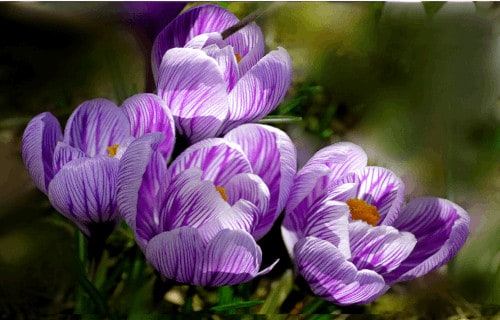
Check out these 7 Stunning European Flowering Plants. The myriad plants in this world that produce flowers provide us with some of the greatest beauty on earth. Although such magnificent botanical glory exists in almost every part of the globe, Europe certainly has its share. We hope that you thoroughly enjoy what you read here in this article, and come away with a renewed sense of appreciation for the bounty of Nature.
Naked Man Orchid
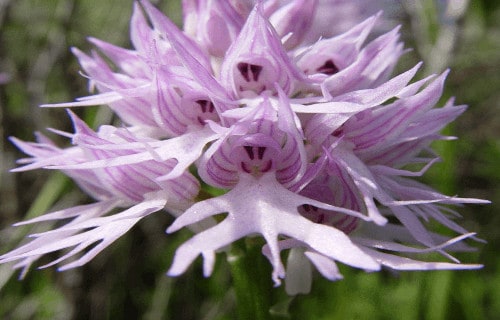
CCL: https://bit.ly/1p2b8Ke
Naked Man Orchid Facts
- Leading off our list of 7 Stunning European Flowering Plants is the bewildering, though appropriately named, Naked Man Orchid.
- Firstly, this astounding orchid is a really unusual species of orchid. Most notably, this image does not include photoshopping and shows exactly why the remarkable plant bears its common name.
- This astonishing flower also remains one of the fortunate ones and currently lists with the IUCN as a Species of Least Concern.
- Although it does not rank as endangered now, the known numbers of the species appear to be declining rapidly, for a variety of reasons.
- Finally, despite its current listing, all orchid varieties are protected by the Convention on International Trade in Endangered Species of Wild Fauna and Flora.
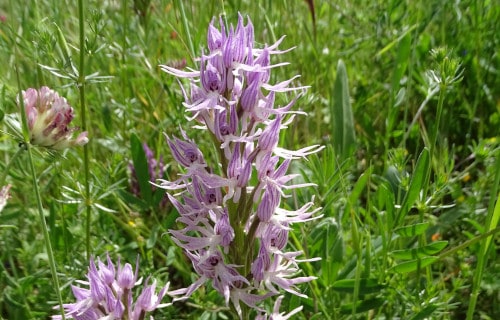
CCL: http://bit.ly/2JszWtI
Naked Man Orchid Physical Description
To start with, the most obvious characteristic of the Naked Man Orchid remains the oversized lobed lip of every flower. By a rather amusing quirk of Nature, this vaguely resembles the general shape of a naked man.
The plant produces a single stalk that typically attains a height of roughly 20 in (50 cm). Several short, light green leaves may also be present on occasion.
The uniquely shaped flowers of this hermaphroditic plant also appear in large clusters and present varying shades of pink. Two dark circles resembling eyes also develop. Not every bloom displays the eye-like spots. Further, the plant also produces numerous tubers, which are edible.
- Kingdom: Plantae
- Phylum: Angiosperms
- Class: Monocots
- Order: Asparagales
- Family: Orchidaceae
- Genus: Orchis
- Species: O. italica
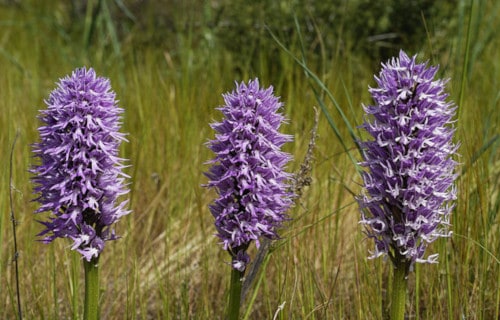
CCL: http://bit.ly/2IjEG4n
Naked Man Orchid Distribution, Habitat, and Ecology
The Naked Man Orchid is native to the Mediterranean region. The Orchis italica occurs in Portugal, Spain, Italy, Serbia, Greece, the Aegean islands, Turkey, Cyprus, Malta, Syria, Jordan, and also northern Africa.
It grows at altitudes of up to 4,300 ft (1,300 m), and prefers areas of direct sunlight. It will also flourish in a wide range of soil types, as long as it has adequate drainage
The Orchis italica also most commonly appears in fertile meadows or light forests. Finally, it typically blooms between March and May and grows in large groupings.
Lily of the Valley
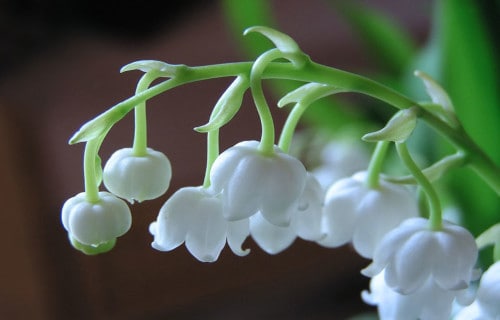
Lily of the Valley Facts
- Listing as second on our list of 7 Stunning European Flowering Plants is the delicate beauty known as the Lily of the Valley.
- Firstly, this gorgeous plant represents a distinctly sweetly scented flowering plant, with an unusual habitat range.
- In addition, many researchers believe that this stunning beauty forms the only extant species within its genus.
- This remarkable flower has also become a popular garden plant, in those regions of the world with the appropriate climate.
- The plant generally flowers in late Spring. However, in mild winters in the greater part of its range, this takes place in early March.
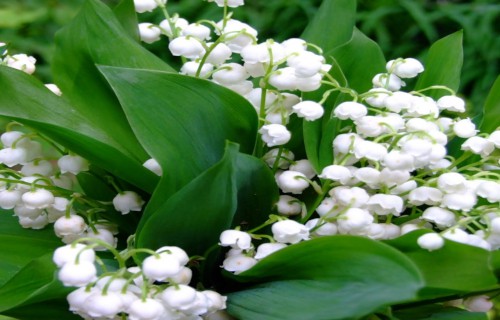
Lily of the Valley Physical Description
The Lily of The Valley is an amazing species of herbaceous perennial plant. It forms extensive colonies by extending underground stems. New upright shoots generally form in the Summer, and these grow in the spring into new leafy shoots. Yet, these shoots still remain connected to the other shoots underground. In this way, the Lily of The Valley often forms extensive colonies.
The delicate flowers have six white sepals. On rare occasions, these sometimes develop as pink in color. In addition, these form a bell-shape, averaging 0.4 in (10 mm) in diameter.
Finally, the fruit appears as a small orange-red berry.
- Kingdom: Plantae
- Phylum: Angiosperms
- Class: Monocots
- Order: Asparagales
- Family: Asparagaceae
- Genus: Convallaria
- Species: C. majalis
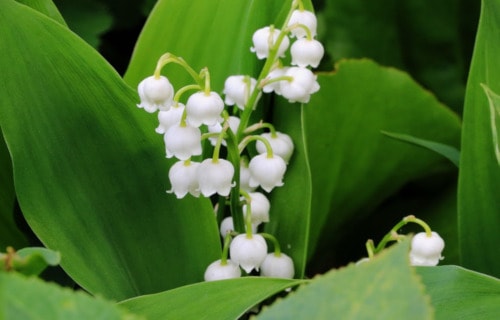
Lily of the Valley Distribution, Habitat, and Ecology
Most notably, the Lily of the Valley seems to have evolved as endemic to regions throughout the cool temperate Northern Hemisphere. This region includes Asia, Europe, and, rather mysteriously, certain portions of the southern Appalachian Mountains in the United States.
The population in the Appalachian Mountains appears to be rather sparse. There also remains some debate among botanists as to whether this population evolved as endemic or occurs as the result of transplantation.
The Lily of The Valley is a plant that prefers partial shade and warm summers. Yet it thrives in soils that are silty or sandy, and acidic to moderate basic. It is a sub-oceanic and Eroasiatic species which does best in mountainous regions at altitudes of up to 4921 ft (1,500 m).
Despite its delicate beauty, the marvelous plant is extremely toxic! All parts of the plant contain toxins, including the berries. Even small amounts become dangerous if ingested.
Crocus

Crocus Facts
- The third entry on our list of 7 Stunning European Flowering Plants is the simply named but always truly breathtaking Crocus.
- Firstly, the term itself represents a well-known genus of flowering plants. These beautiful plants are part of the Iris family. Currently, botanists recognize 90 varieties of Crocus.
- All of these also develop as perennials and grow from corms. Further, many varieties of these plants get cultivated for beautiful flowers.
- Dependent upon the species, these delicate flowers bloom in either Autumn, Winter, or Spring.
- Most notably, the early cultivation and harvesting of the unique type of Crocus began in the Mediterranean, and most predominantly – on the island of Crete.
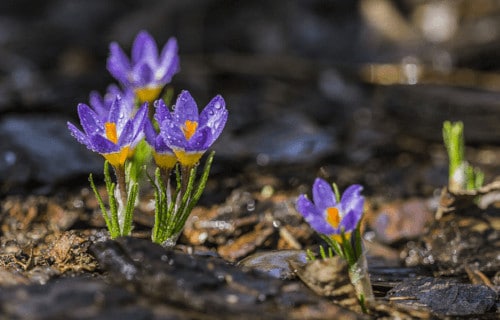
Crocus Physical Description
The majority of known Crocus forms grow as either cup-shaped, solitary, or salverform in nature. The flower typically tapers off into a narrow tube.
Its colors also frequently vary substantially. However, lilac, mauve, yellow, and white generally predominate. In addition, the leaves generally appear grass-like, and ensiform. These also typically display a white central stripe along the leaf axis, and the leaf margin in total.
The plant typically has a total of three stamens. Notably, the popular spice saffron derives from the stigmas of one particular species. That species bears the name of the Crocus sativus, and generally blooms in the Autumn.
- Kingdom: Plantae
- Phylum: Angiosperms
- Class: Monocots
- Order: Asparagales
- Family: Iridiceae
- Genus: Crocus
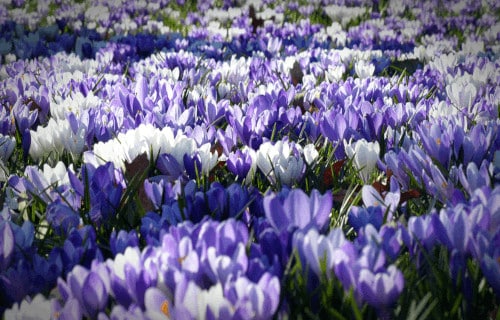
Crocus Distribution, Habitat, and Ecology
Firstly, the native range of the Crocus includes portions of Europe, the Middle East, Northern Africa, Aegean Islands, and portions of Asia, including China.
Furthermore, the gorgeous plant evolved as endemic to woodland, scrub, and meadows, and grows from sea level to alpine tundra regions.
Depictions of this practice appear in Akrotiri, Knossos, and Santorini. In addition, humans introduced the first of these to the Netherlands around 1560. These arrived from Constantinople via the Roman Empire’s ambassador.
Within 60 years, new varieties already appeared in development. These included several cream-colored varieties. Some of these varieties still remain popular with gardeners.
Orpheus Flower
Orpheus Flower Facts
- The next entry on our list of 7 Stunning European Flowering Plants is the beautiful and absolutely amazing Orpheus Flower.
- Firstly, many experts consider the most noteworthy fact about this lovely flower to be its remarkable hardiness. The plant has the ability to survive for extended periods without water and to spring to life when receiving some. As a result of this ability, some call it the resurrection plant.
- It also has a restricted range of habitation. Yet it appears to be quite plentiful within that range. In addition, much of its endemic range coincides with various nature reserves and one national park. Due to this, the IUCN lists the Orpheus Flower as a species of Least Concern.
- While it benefits from the protected status of much of its range, botanists still worry about its future. Its beauty leads many visitors to the protected sites, tourists and locals alike, to collect wild plants. Further, ongoing road construction in and around the national park and nature poses a threat to the species.
Orpheus Flower Physical Description
Many botanists remain confused over how to classify the Orpheus Flower. This confusion occurs due to its nature. While it typically stays small, the plant also is capable of attaining a height of as much as 5.5 ft (1.7 m).
Therefore, experts remain further divided over whether it ranks as a flowering plant or a small shrub. Regardless, this lovely plant, therefore, holds the status of being both an evergreen and a perennial.
The leaves possess a rosette shape, with lacerated edges, and display a dark green color. Yet the flowers remain its most noteworthy feature. These present in different combinations of either violet, white, purple, or red.
- Kingdom: Plantae
- Phylum: Angiosperms
- Order: Lamiales
- Family: Gesneriaceae
- Genus: Haberlea
- Species: Haberlea rhodopensis
Orpheus Flower Distribution, Habitat, and Ecology
The stunning Orpheus Flower also has a very specific and somewhat limited habitat range which also happens to be quite fragmented. That occurs because the species grows endemically only in a small part of Greece, and primarily in Bulgaria.
Even there, however, it only grows on several mountains, and primarily on the Rhodope mountains. The species grows naturally on rocky slopes with relatively poor soil, and only on the northern sides.
The plant also has another distinctive feature. Bees perform only a small portion of its pollination, while the majority remains carried out by random insects! In fact, various species of flies endemic to the region serve as the major pollinators for the species.
It remains best known for its extraordinary ability to survive for up to 3 years without water.
Honeysuckle
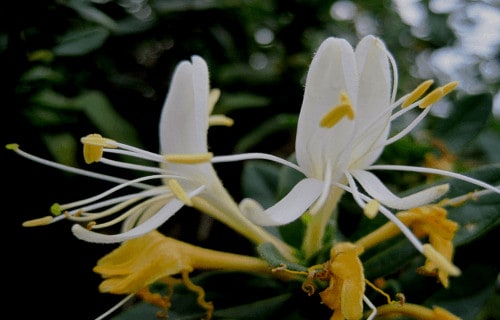
Honeysuckle Facts
- The fifth entry on our list of 7 Stunning European Flowering Plants is the plant whose name describes it perfectly, the Honeysuckle.
- Firstly, this appropriate term names a family of arching shrubs or twining vines in the rather extensive Caprifoliaceae family.
- Further, all known varieties of this sweet-smelling and brilliant plant evolved as native to the Northern Hemisphere.
- Furthermore, about 180 known species of the plant exist, with approximately 100 of those endemic to China.
- Finally, another 20 species occur in Europe, India and, North America each, making it an extremely widespread family.
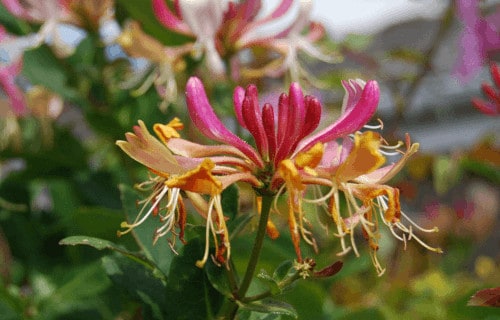
Honeysuckle Physical Description
Most notably, the majority of species of Honeysuckle evolved as strong twining climbers. The leaves grow opposite, and simple ovals and they also average about 4.5 in (10 cm) in length. Most varieties are deciduous, however, some develop as evergreens.
In addition, many of the species have sweetly-scented flowers that produce sweet, edible nectar. Most flowers also develop in clusters of two.
Both shrubby and vining sorts have strongly fibrous stems which are suitable for binding and textiles.
The fruit of the Honeysuckle appears as a red, blue or black spherical or elongated berry. These berries contain several seeds and in most species, the berries are mildly poisonous.
- Kingdom: Plantae
- Phylum: Angiosperms
- Class: Eudicots
- Order: Dipsacales
- Family: Caprifoliaceae
- Genus: Lonicera
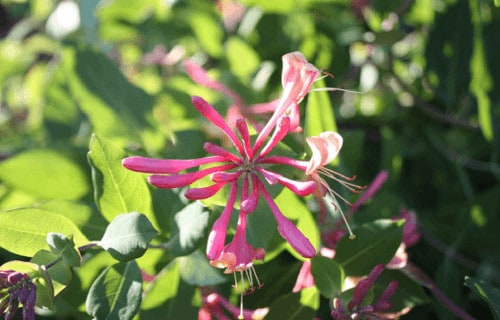
Honeysuckle Invasiveness
While the fruit of many varieties of Honeysuckle evolved to be toxic, in a few cases, these can be consumed and even used for commerce.
The berries of most forms also remain attractive to wildlife. For example, butterflies and hummingbirds love them.
Furthermore, several species of this genus have become invasive when introduced outside their native range.
This remains particularly true in both New Zealand and the United States.

Honeysuckle Popularity
The Honeysuckle is widely popular as garden decoration as it both smells beautiful and can cover unsightly walls and outbuildings.
In addition, this gorgeous and colorful plant has become quite popular for its beautiful and highly aromatic flowers in summer.
Finally, the hardy climbing types need the roots in shade but the flowering tops prefer sunlight or very light shade. Varieties need to be chosen with care because most grow prolifically.
Lotus Corniculatus
Lotus Corniculatus Facts
- The sixth entry on our list of 7 Stunning European Flowering Plants is the beautiful Lotus Corniculatus.
- Firstly, the beautiful species represents an unusual small flowering plant. Believe it or not, it actually constitutes a member of the pea family!
- However, you do not want to eat it – it actually contains trace amounts of naturally occurring cyanide 🙂
- In extremely small amounts, however, this beautiful and remarkable species does have some medicinal uses.
- Surprisingly, the gorgeous Lotus Corniculatus actually gets widely used as a source of forage for livestock.
- The majority of livestock, fortunately for them, have a much greater natural tolerance for small concentrations of cyanide than humans.
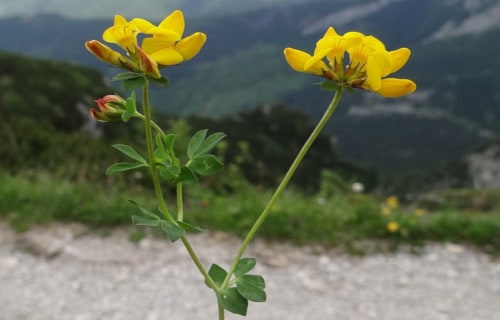
CCL: http://bit.ly/2P4R3Ic
Lotus Corniculatus Physical Description
Most notably, though seemingly rather delicate, the Lotus Corniculatus is a surprisingly hardy perennial species.
This herbaceous plant also achieves a maximum known height of nearly 8 in (20 cm) unless supported by other plants. It grows in a sprawling manner along the ground.
In addition, its small flowers display combinations of orange and yellow color. The seeds (not surprisingly since it is part of the pea family) develop in small, elongated pods.
Also, the leaves of the plant grow in groups of five. Typically, three of these form a trefoil pattern over the other two.
- Kingdom: Plantae
- Phylum: Angiosperms
- Class: Eudicots
- Order: Fabales
- Family: Fabaceae
- Genus: Lotus
- Species: L. corniculatus
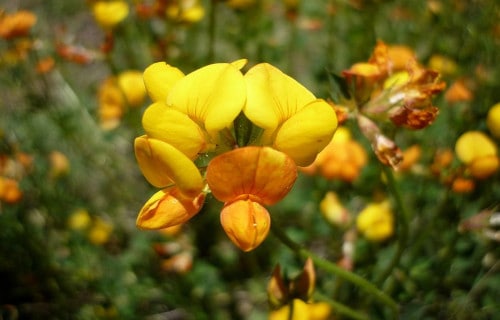
CCL: http://bit.ly/2GGxvUT
Lotus Corniculatus Distribution, Habitat, and Ecology
First off, the Lotus Corniculatus is endemic to a wide swathe of Europe, Asia, and Northern Africa. Within that range, the plant predominantly appears in regions of grasslands.
It has extreme durability, even to the point of surviving being trampled by livestock.
In addition, this species grows equally well in both nutrient-rich soils and nutrient-poor soils. It most commonly grows in areas of grassland with a high percentage of sand.
Farmers often use it in cultivation, especially in Europe. As a result of this practice, it has become considered an invasive species in some portions of Australia and North America.
Snowdonia Hawkweed
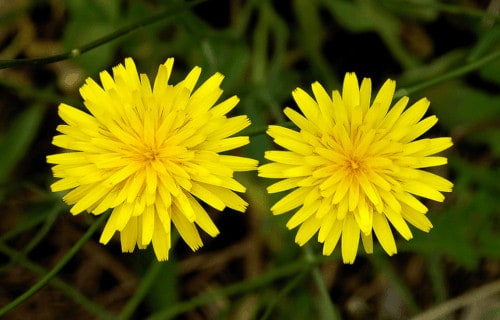
CCL: https://bit.ly/1p2b8Ke
Snowdonia Hawkweed Facts
- Last, but certainly not least, on our list of 7 Stunning European Flowering Plants is the incredible Snowdonia Hawkweed.
- This small, and somewhat mysterious flowering plant easily ranks as one of the rarest plants in the world.
- Scientists first described the plant in 1880. Then, despite numerous expeditions in the intervening decades, the attractive species seemed to disappear sometime prior to 1953. Had it become extinct?
- Then, in 2002, someone accidentally discovered a single plant growing on a remote hillside in a region which forms part of the Cwm Idwal National Nature Reserve.
- Also, how the single plant could appear after so long is a mystery. To date, this lone individual plant is the only one that humans have spotted.
- Though the IUCN does not yet, for unknown reasons, list the species on its site, it certainly meets all the requirements for a status of Critically Endangered.
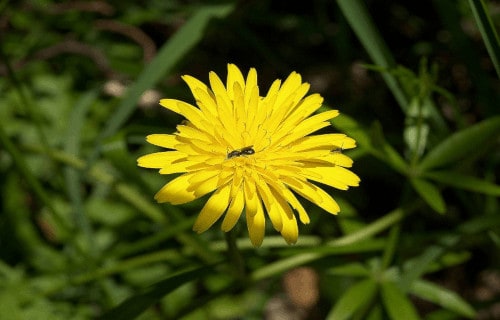
CCL: https://bit.ly/1p2b8Ke
Snowdonia Hawkweed Physical Description
The Snowdonia Hawkweed is a small perennial plant species. In fact, the plant typically attains a height of only about 12 in (30 cm).
The flowers display as a bright golden yellow in color and are produced at the ends of long, delicate stems, often growing in small clusters. Each stem has a small rosette of elongated leaves growing at the base.
Further, numerous tiny black hair-like structures cover both the stems and the backs of the leaves of the Snowdonia Hawkweed.
This plant produces fruit irregularly and reproduces asexually. The fruit ripens after approximately one month and the wind acts as the principal pollinator.
- Kingdom: Plantae
- Phylum: Angiosperms
- Class: Eudicots
- Order: Asyerales
- Family: Asteraceae
- Genus: Hieracium
- Species: H. snowdoniense
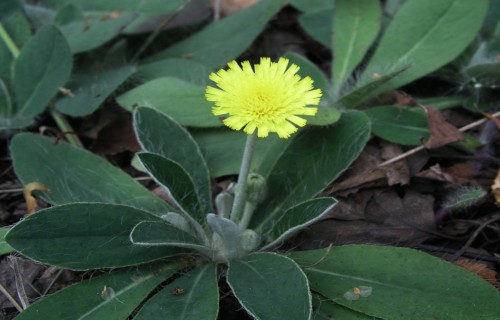
Snowdonia Distribution, Habitat, and Ecology
Firstly, the lovely Snowdonia Hawkweed appears to never have had an extensive range of habitation. Furthermore, when it was first discovered, it only inhabited seven individual mountain ledges in Wales, in Europe.
Obviously, details about the previous habitat, if any, of the flower, remain unknown. It currently only inhabits a rocky, quite steep, and north-facing inaccessible mountain cliff.
In addition, many experts believe that long-term overgrazing by local sheep populations may have led to the current predicament the species faces.
Conservation efforts have started. These include the collection of seeds, in an attempt to establish a new population at the National Botanic Garden of Wales.

CCL: https://bit.ly/1p2b8Ke
7 Stunning European Flowering Plants
We hope that you have enjoyed this article on 7 Stunning European Flowering Plants. Naturally, this list can only cover a small handful of those marvelous plants found throughout Europe. And even those located there account for only a small percentage of those found throughout the entirety of the world. Beauty exists everywhere in Nature if we can only open our eyes to see it, and our hearts to protect it.
Check out our other articles on 5 Pleasing Insects of Portugal, Spectacular Dolphins Throughout Our World, 4 Captivating Marine Crabs, The Mighty Tornado
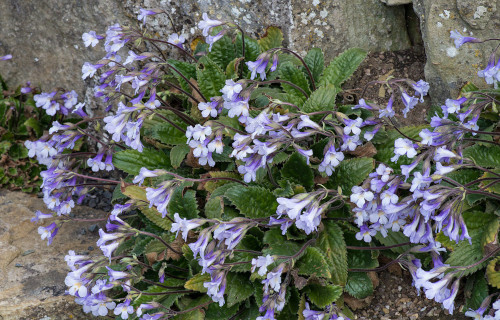
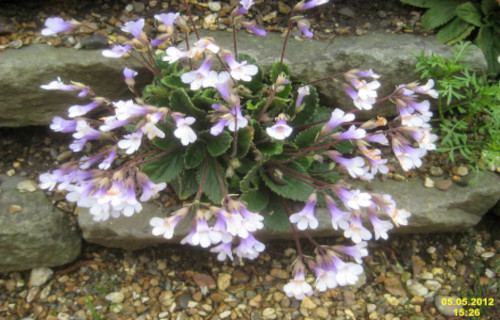
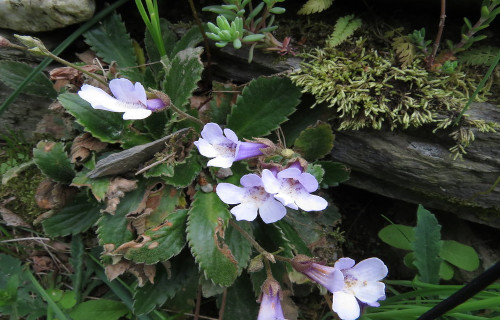
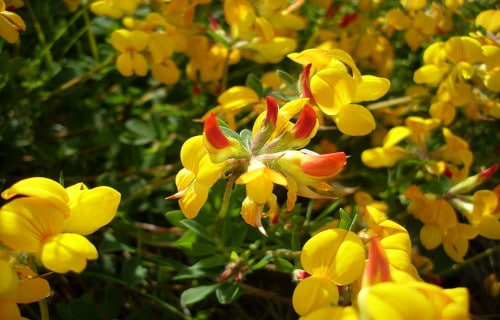









Thanks for all the detail here Todd! Many lists would simply summarise the flowers, but you have really gone above and beyond to give lots of information about each of them. Thanks very much for sharing.
Thank you, Kevin!